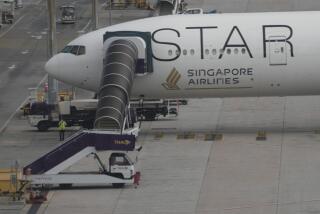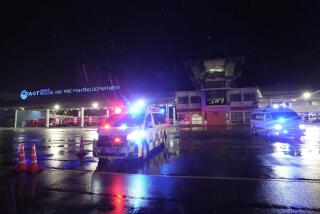AirAsia Flight QZ8501: Possible debris of missing plane spotted
- Share via
Reporting from Jakarta, Indonesia — Several pieces of debris were spotted floating off Borneo Island and could possibly be linked to the AirAsia passenger jet lost over the Java Sea, an Indonesia National Search and Rescue spokesman told the Associated Press.
UPDATE: Missing AirAsia flight: Possible plane debris spotted in Java Sea
An Indonesian military aircraft saw white, red and black objects, including what appears to be a life jacket, off the coast, about 105 miles south of Pangkalan Bun, Yusuf Latif told AP. At least one helicopter was dispatched to this region to retrieve the debris, which includes about 10 pieces. Those items will be taken to the search and rescue coordination post on Belitung Island.
“This is the most significant finding, but we cannot confirm anything until the investigation is completed,” he said.
The search resumed under gray skies Tuesday after the first full day of searching ended with few clues to its disappearance and a grim acknowledgment by one official that “the worst may have happened.”
The U.S. Navy said late Monday it was sending a guided-missile destroyer to help other nations in the region look for the airliner carrying 162 mostly Indonesian passengers and crew. Investigators suspect the plane crashed into the water after losing contact during a severe thunderstorm.
The San Diego-based destroyer Sampson was in the midst of a deployment in the western Pacific Ocean and was expected to reach the scene Tuesday. It will join more than 30 ships and 15 aircraft from Indonesia, Malaysia, Singapore, Australia and South Korea — including surveillance planes that flew 10 hours or more Monday over a choppy Java Sea, the focal point of the search.
Bambang Soelistyo, the head of Indonesia’s National Search and Rescue Agency, which was leading the operation, said the search area would be expanded Tuesday to include land areas on the western edge of the island of Borneo and on two smaller islands off Sumatra.
But more than 48 hours after the plane disappeared during a two-hour flight to Singapore from the Indonesian city of Surabaya, what were thought to be the first tantalizing traces of Indonesia AirAsia Flight 8501 turned out to be false alarms.
What might have been an oil slick about 105 nautical miles off Belitung island near the Karimata Strait, which connects the archipelago nation to Singapore, was determined Tuesday morning to be “a group of rocks,” Bambang said. A weak signal from an object in the water detected by an Australian surveillance plane turned out to be from a personal locator beacon, not the AirAsia jet’s emergency transmitter.
“We pursued every lead and piece of information,” Bambang said, but investigators had no indication of the Airbus A320-200’s whereabouts.
Search officials said Monday that, based on the coordinates of Flight 8501’s last known location, the plane was probably, as one stated, “at the bottom of the sea.” While vowing the hunt would continue as long as needed, Indonesian Vice President Jusuf Kalla acknowledged that prospects were bleak for finding survivors.
“We pray for them,” Kalla said, “but we realize the worst may have happened.”
Investigators are combing a roughly 250-mile-wide search zone centered in the Java Sea between Sumatra and Borneo, waters that officials say run 130 to 160 feet deep. That is far shallower than the Indian Ocean, where Malaysia Airlines Flight 370 was believed to have been lost in March, leading experts to speculate that the AirAsia plane would soon be found.
Singapore civil aviation officials said they would send two teams of specialists, underwater locator beacons, a sonar system to detect objects on the seafloor, and other equipment. A South Korean Orion search plane was expected to join the hunt Tuesday, Bambang said.
The U.S. Navy said it was “working closely” with Indonesia to identify additional ships or aircraft that could assist with the effort after Indonesia on Monday asked the U.S. Embassy in Jakarta for help.
“We’re reviewing the request to see how best we can meet it,” State Department spokesman Jeff Rathke in Washington told reporters. No American citizens were aboard the flight, he said.
A Pentagon statement said the U.S. aid could include “some air, surface and subsurface detection capabilities.”
Speculation on the plane’s fate focused on air traffic control data showing that its forward airspeed had slowed substantially, to 353 knots, or about 406 mph, well below what is needed for the jet to sustain flight, according to aviation analysts. At the same time, the plane was at an altitude of 36,300 feet and climbing, suggesting that the aircraft could have struck a violent vertical updraft as it tried to maneuver around a major storm during an unusually heavy monsoon season in Southeast Asia.
“If he was encountering severe thunderstorms, it’s possible he was caught in a severe updraft,” Geoffrey Thomas, editor in chief of airline safety website AirlineRatings.com, said of the pilot. “All of a sudden, you’re going vertical, not forward. It’s an express elevator to hell.”
The plane departed Surabaya roughly on schedule at 5:35 a.m. Sunday. Indonesian transportation authorities said the pilot communicated with air traffic controllers at 6:12 a.m., asking permission to take a left turn off the scheduled flight path and climb from 32,000 feet to 38,000 feet to avoid clouds.
State-owned AirNav Indonesia, which provides navigation services, approved the left-turn request but relayed the altitude question to Singapore, which said the plane could climb only to 34,000 feet because of other aircraft in the area, the Jakarta Post reported.
“But when we informed the pilot of the approval at 6:14 a.m., we received no reply,” AirNav safety and standard director Wisnu Darjono told the newspaper.
The plane disappeared from radar at 6:18 a.m.
Another factor, aviation analysts said, could have been that the jet was equipped with a standard weather radar that reads moisture but is less adept than more advanced systems at reading ice and other dangerous conditions that develop at high altitudes during storms.
In an area known for massive thunder showers with cumulonimbus clouds that can reach heights of 60,000 feet or more, the twin-engine Airbus, which has a maximum altitude of about 40,000 feet, would probably not have been able to climb over the storm.
“It’s possible the pilot misread or got a false return from his radar, or he didn’t understand the intensity of what was in front of him until too late,” Thomas said.
There have been few red flags about the aircraft — which Airbus delivered to AirAsia straight from the production line six years ago and which last underwent regular maintenance in November — or the pilot, identified by Indonesian news media as Iriyanto, who had accumulated more than 20,000 flight hours, 6,000 with AirAsia. Like many Indonesians, Iriyanto has just one name.
AirAsia Chief Executive Tony Fernandes defended his airline’s safety record, saying it had carried 220 million passengers in 13 years and never had a fatal accident.
“Until we have a full investigation, we don’t want to speculate,” Fernandes said at a news conference in Surabaya. “It’s premature to talk [about what went wrong] at the moment. We are confident in our ability to fly people. We’ll continue to be strong and continue to carry people who never could fly before.”
Indonesian Transportation Minister Ignasius Jonan said the government would review AirAsia’s operations “to ensure that in the future its activity will be better.” The low-cost carrier, which is based in Malaysia and operates mainly short flights across Southeast Asia, has a strong safety record and is widely regarded as one of the world’s most successful budget airlines.
The AirAsia incident was the third disaster this year involving a Malaysian airline. Malaysia Airlines Flight 370 vanished in March en route to Beijing from Kuala Lumpur, Malaysia, with 239 people aboard and is still missing. The same carrier’s Flight 17 was shot down over eastern Ukraine in July, killing all 298 passengers and crew.
Families of the 155 passengers and seven crew members from the AirAsia flight gathered at Surabaya’s airport and Changi International Airport in Singapore, where airline and government officials had set up crisis centers. Among those on board were 17 children and one infant, the airline said.
A tearful Hartatik Sukorini told Indonesia’s TVOne news channel that her daughter Dona was on the plane, and said she was hoping for “a miracle.”
“I pray to God that she is safe and protected,” she said. “She is a good daughter and never causes me any trouble.”
Times staff writer Bengali reported from Mumbai, India, and special correspondent Pathoni from Jakarta. Staff writers Alexandra Zavis in Los Angeles and W.J. Hennigan in Washington contributed to this report.
For more news from Asia, follow @SBengali on Twitter.
More to Read
Sign up for Essential California
The most important California stories and recommendations in your inbox every morning.
You may occasionally receive promotional content from the Los Angeles Times.











